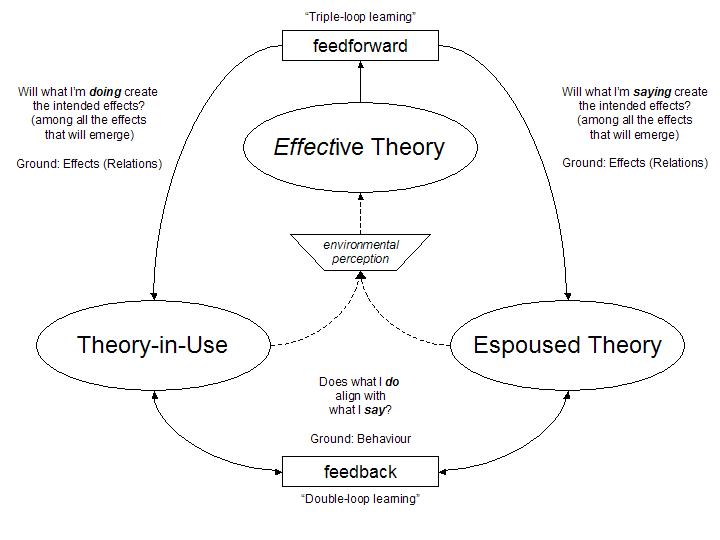Argyris & Schön (1974) describe the now classic “theory of action” perspective on what we say, as compared to what we do – espoused theory vs. theory-in-use. A person’s, or an organization’s, theories of action are subject to a variety of dilemmas that relate to the gap between espoused and in-use theories. First, there is the potential for incongruities between espoused and in-use theories. Next, there is the potential for inconsistencies among the actions that comprise one’s theory-in-use. As well, the requisite actions may become difficult to achieve, or may provide less value to the person, organization, or the world in general. Finally, something that Argyris writes about relatively more recently, are the defensive measures that people and organizations take to mitigate or avoid the embarrassment that may be associated with these dilemmas, especially if one feels a need to continually justify past decisions.
To deal with these dilemmas requires corrective action, not only to correct specific behaviours associated with theory-in-use, but to adjust one’s theory-in-use, perhaps to bring it more in line with the corresponding espoused theory. Argyris calls such reflective action “double loop learning,” involving a reflection not only on whether the theory-in-use is effective (as in accomplishing goals, for instance), but also whether: theory-in-use is compartmentalized from espoused theory when there are inconsistencies; there is willing deception of salient data that would expose incongruities; “bad news” is suppressed through intimidation or other power/control mechanisms (including coercive control and punishment); espoused theory is being inappropriately changed to correspond to theories-in-use and actual behaviours; marginal changes to theories-in-use are being introduced so that they are technically consistent with espoused theories.
Despite this, the question that remains is whether the espoused theory actually accomplishes the organization’s intent relative to its total environment, the aspect that I refer to as organizational effectiveness. This aspect requires the type of anti-environment – either via external perceivers or through the construction of a cognitive anti-environment – that is effected via McLuhan for Managers-style thinking constructs, or through a role*-like process of guided narrative for the organization itself (through people’s individual narratives, and the narrative of the organization as an entity via its documentary history). This additional consideration – essentially adding a “third loop” – begins to impose a consideration of environmental responsibility on the organization. Of course I’m referring to the total environment in which the organization exists that necessitates a change in focus for the traditional organization, from inner to outer; from considering only its relationship with its nominal stakeholders to considering itself “in relation” to its place in the world.
Click for larger image

Reference:
Argyris, C., & Schön, D. (1974). Theory in practice: increasing professional effectiveness. San Francisco: Jossey-Bass Publishers.
Update (13 July 2010): The fully worked out version of Effective Theory, plus my entire Valence Theory of Organization, are available via the links.
[Technorati tags: argyris | espoused theory | theory-in-use | double loop learning | effective theory | organizational effectiveness]
1 comment:
just a bit of rambling thoughts...
? espoused theory = formal strategy, supported by formal policies (decisions) aligned with it (or at least the underlying theory as to why the strategy should work).
? theory in use = the difference between policy and practice; the walk compared to the espoused "talk",
When differences are meaningful, "undesirable effects" are the result, often explained by cause-and-effect analysis stemming from clashes between the formal policies and measures vs the informal practices and behaviors (culture?), exacerbated by the reality of the environment.
? marginal changes in espoused theory - not necessarily so marginal when it comes to implementation. While some tweaks in policies and metrics can impact behavior/practice and performance, even getting to those tweaks often involve an assault on deeper assumptions associated with the espoused theory. ex...Common erroneous assumption: Productivity is directly related to maximum utilization of all resources. Not hard to disprove, but someone needs to be open to listen.
It's the assumptions that are the real root cause of the undesireable effects.
Like I said, ramblings, trying to understand in terms of my Theory of Constraints Thinking Processes background.
Post a Comment